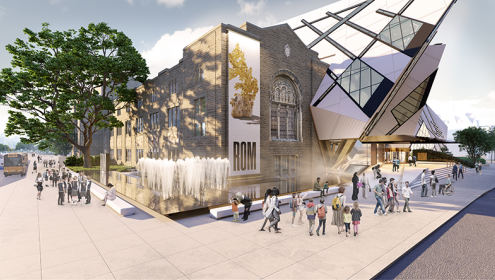
In February 2024, ROM proudly announced the launch of OpenROM, a multi-faceted initiative that will dramatically open the Museum up even more to the public, creating a thriving cultural and civic hub in the heart of the city.
Grounded in ROM’s overarching vision to further enhance visitor access and engagement, OpenROM includes a sweeping architectural transformation of the Museum’s main floor and a redesigned Bloor Street entrance that will deepen ROM’s connection to the city. Work began in early 2024, and the Museum will remain open to visitors throughout the three-year construction period.
Funded by private philanthropy, this landmark revitalization project has been catalyzed by a $50-million donation from the Hennick Family Foundation–the largest cash gift in ROM’s history. Fundraising efforts are active and ongoing.
Once construction is completed, OpenROM will introduce ongoing free access to the Museum’s main floor. This builds on the proven success of ROM’s summer-long Free Main Floor pilot program, which was introduced in 2022 and returned in 2023 and 2024, all thanks to the generous support of the Temerty Foundation. OpenROM’s expansive architectural design, coupled with year-round free admission to the Museum’s entire main floor, as well as unlimited access to special programming, live performances, and hands-on activities, will make ROM an even more vital cultural anchor and gathering place for Ontarians.
“OpenROM is more than a physical transformation; it is a major leap forward in the Museum’s ongoing evolution to becoming an even more welcoming and accessible space,” says Josh Basseches, ROM Director & CEO. “This is an opportunity to truly throw the doors of the Museum open, both literally and figuratively, and invite more people in to experience all ROM has to offer. We want people from down the block and around the world to feel like this is a place that speaks to them, where they are inspired and belong.”
Siamak Hariri, of the award-winning Toronto-based firm Hariri Pontarini Architects, leads the design. Building on the iconic, Daniel Libeskind-designed Michael Lee-Chin Crystal, OpenROM will transform 86,000 square feet on the main floor and create 6,000 square feet of new gallery space on the second and third levels, deepening the visitor experience with the Crystal and providing greater access to ROM’s world-class collection.
“We’re going to re-introduce ROM to Toronto with a design that, in effect, turns the Museum inside out,” says Siamak Hariri. “We’re going to bring daylight and views deep inside and create new connections with Bloor Street, within the ground floor public spaces and the galleries themselves.”
In addition to reimagining the core of the Museum, the project includes enhancements to the exterior spaces. Animating one of the most notable intersections in Toronto, a new showcase water feature will wrap around the heritage façade at the corner of Bloor Street and Queen’s Park. This fountain will evolve with the seasons, changing from burbling water in the summer to cracked ice in the winter, in a nod to frozen Canadian landscapes.
Anchoring the exterior will be a newly designed and fully accessible Bloor Street entrance, sheltered by an expansive bronze canopy. The seamless floor-to-ceiling glass entryway—the future Hennick Entrance—will offer pedestrians direct sightlines into the building, creating a porous connection between the Museum and the neighbourhood.
Inside, visitors will enter a bright, open foyer, featuring artworks and specimens from ROM’s extensive collection, with an unobstructed vista into the Museum. An oculus—a giant, circular portal in the ceiling—will draw visitors’ eyes upwards, bathing the entryway in light and offering a view of the remarkable dinosaur galleries above.
The foyer will lead into the new heart of the Museum: Hennick Commons, a soaring, sunlit four-storey atrium capped with a sweeping, high-performance diagrid glass ceiling. There, visitors will encounter a new, 2,400-square-foot forum, where audiences will enjoy regular performances, programs, and hands-on experiences. Adjacent to the forum will be a grand multi-level, lily pad staircase, which will offer three accessible overlook platforms for surveying the Museum and knit together old and new wings of the building to improve mobility. The Hennick Commons will be a vibrant hub and public plaza; a place for gathering, learning, and exchange.
ROM’s extensive multi-year renewal plan began with the reopening of the Weston Entrance on Queen’s Park in 2017. In 2019, ROM introduced a new public outdoor space with the unveiling of the Helga and Mike Schmidt Performance Terrace and the Reed Family Plaza on Bloor Street. And in 2021, the Museum opened the Willner Madge Gallery, Dawn of Life—the first major permanent gallery of its kind anywhere in the world.
“We are honoured to serve as catalyst donors for a transformational vision for the Royal Ontario Museum,” say Jay and Barbara Hennick. “OpenROM reimagines the visitor experience and will help to revitalize civic life in our great city. It's finally time for the ROM to take its rightful place among the very best museums in the world”.
“This cherished cultural institution offers exhibits and programming that appeals to all ages and interests," says Neil Lumsden, Minister of Tourism, Culture and Sport (2022-2024). "OpenROM will enable Canada’s largest museum to welcome even more visitors – fostering community, learning and cultural connections. I look forward to the completion of this project and seeing firsthand the many benefits that it will offer the people of Ontario."
"The next in a series of bold architectural initiatives, OpenROM will elevate the Museum’s role as a vital Toronto landmark, recognized as Canada’s preeminent museum and one of the world’s great cultural institutions,” says Basseches.
Learn more about how you can support OpenROM.
